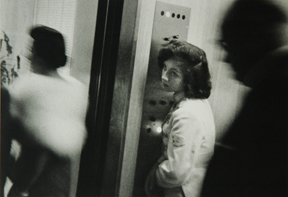“Robert Frank, Swiss, unobtrusive, nice, with that little camera that he raises
and snaps with one hand he sucked a sad poem right out of America onto film…” (Frank 9).

This quote from Kerouac’s introduction to The Americans sums up Robert Frank’s position as a photographer. He takes in the world and shows us what he sees, quietly and modestly, frequently unsentimentally but never condescendingly. As his photographs from Peru show, Frank goes for the direct, the emotional, and the true nature of his subjects (Beardsley 362). An accidental Beat, Frank finds the need to wander to make his art, which finds its interest in that certain area of the mundane that we never think about until it is pointed out to us.
With his photographs, Robert Frank wanted to make people “feel the way they do when they want to read a line of a poem twice”. His work is about recollection and memory, getting the non-linear series of moments that we revisit in our minds on film. As such, Frank’s images have become icons of our collective memory, effectively blurring the line between photography, memory, and knowledge (Van Reis 6). His photographs in The Americans were generally about the tensions between the 1950s façade and the reality of racial and class discrimination (Wikipedia 1), but they never said this explicitly; people were left to their own conclusions.
The technical aspects of Frank’s photography were built on what he desired to depict instead of traditional assumptions. He switched to 35mm film and available light (instead of studio lighting or a flash) long before his contemporaries. He embraced the uncontrollable element of this developing technology to show a sort of freedom and uniqueness in his work (Livingston 305). This was not always well received: Popular Photography reviewed his work as “meaningless blur, grain, muddy exposures, drunken horizons and general sloppiness” (Wikipedia 1). Adding to this deviation, Frank relied on montage (not to be confused with photomontage) for presentation, a method borrowed from film (About 1). He manipulated this method into book form, sequencing his images based on a personal idea of their interconnection (Beardsley 362).
Frank seems to have tapped into some key part of the American psyche, skyrocketing him to fame as the symbol of modern photography. Everyone saw Frank’s images as something fundamentally new (Livingston 304), a break from the McCarthy era art that ignored or denied any problems with America. It was such a break that Frank was actually arrested twice while taking photographs for The Americans (Beardsley 363). Through this fame he opened the doors to a new form of black and white photography, one in which breaking the rules was not only acceptable, but mandatory (Livingston 304). Frank also influenced how photographs were viewed, substituting the series for the single photograph as “the photographic work” (About 1).
It can seldom be said that an idea is complete and unable to be built upon, but Robert Frank has accomplished this in The Americans (Ruscha 1). He can be seen as an inspiration, but never a source in the traditional sense (unless one is okay with unabashedly copying). So I find Frank’s ideas compelling, his modesty humbling, but never will undertake to continue on the path he began. I am particularly impressed by his lack of condescension or negative feeling toward his subjects. Instead of pointing out the problems with our society, he merely records his view of it, as if to say, “look at this” and nothing else. We are left to draw our own conclusions. Frank manages to tap into the democracy (or is it socialism?) of photography: his are pictures of all of us (Ruscha 1). I want to capture something of this cultural memory, the feeling that we already know these images. I want that sense – not of timelessness, as Franks pictures are very specific temporally – but of some sort of social timefulness, one that we all know.
